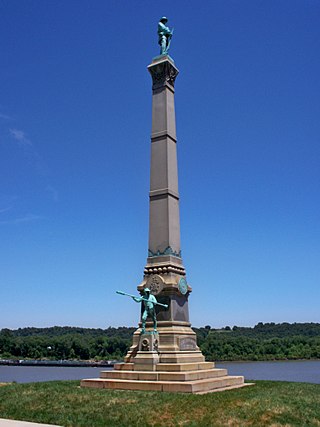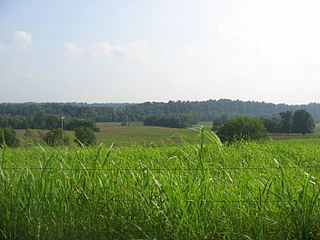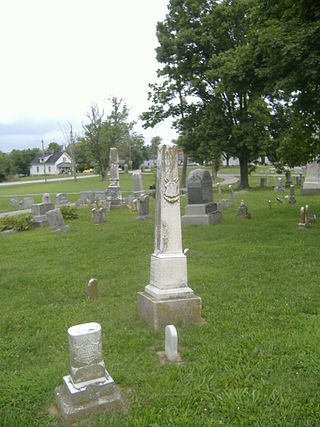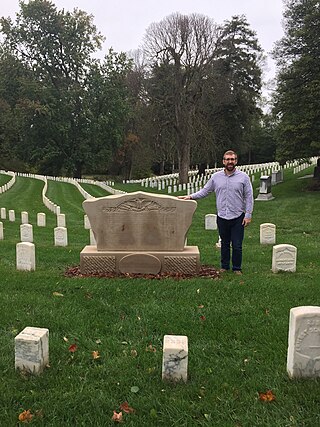
The Battle of Munfordville was an engagement in Munfordville, Kentucky during the American Civil War. Victory there allowed the Confederates to temporarily strengthen their hold on the region and impair Union supply lines.

Cave Hill Cemetery is a 296-acre (1.20 km2) Victorian era National Cemetery and arboretum located at Louisville, Kentucky. Its main entrance is on Baxter Avenue and there is a secondary one on Grinstead Drive. It is the largest cemetery by area and number of burials in Louisville.

The 5th United States Colored Cavalry was a regiment of the United States Army organized as one of the units of the United States Colored Troops during the American Civil War. The 5th USCC was one of the more notable black fighting units. It was officially organized in Kentucky in October 1864, after its first two battles. It was commanded by Colonel James Brisbin until February 1865, when he took over the 6th US Colored Cavalry. His executive officer, Louis Henry Carpenter, commanded the regiment until 20 March 1866.

The Confederate Monument in Louisville is a 70-foot-tall monument formerly adjacent to and surrounded by the University of Louisville Belknap Campus in Louisville, Kentucky, United States. Relocation of the monument to Brandenburg, Kentucky, along the town's riverfront began November 2016, and was completed in mid-December. The granite and bronze structure was erected in 1895 by the Muldoon Monument Company with funds raised by the Kentucky Woman's Confederate Monument Association. The monument commemorates the sacrifice of Confederate veterans who died in the American Civil War.

The Battle of Tebbs' Bend was fought on July 4, 1863, near the Green River in Taylor County, Kentucky during Morgan's Raid in the American Civil War. Despite being badly outnumbered, elements of the Union army thwarted repeated attacks by Confederate Brig. Gen. John Hunt Morgan's dismounted cavalry.

Stephen Gano Burbridge, also known as "Butcher" Burbridge or the "Butcher of Kentucky", was a controversial Union general during the American Civil War. In June 1864 he was given command over the Commonwealth of Kentucky, where guerrillas had carried out attacks against Unionists. He imposed martial law and was criticized for punitive actions against persons accused of being guerrillas.

Thomas Elliott Bramlette was the 23rd Governor of Kentucky. He was elected in 1863 and guided the state through the latter part of the Civil War and the beginning of Reconstruction. At the outbreak of the war, Bramlette put his promising political career on hold and enlisted in the Union Army, raising and commanding the 3rd Kentucky Infantry. In 1862, President Abraham Lincoln appointed him district attorney for Kentucky. A year later, he was the Union Democrats' nominee for governor. Election interference by the Union Army gave him a landslide victory over his opponent, Charles A. Wickliffe. Within a year, however, federal policies such as recruiting Kentucky Negroes for the Union Army and suspending the writ of habeas corpus for Kentucky citizens caused Bramlette to abandon his support of the Lincoln administration and declare that he would "bloodily baptize the state into the Confederacy".

Kentucky was a southern border state of key importance in the American Civil War. It officially declared its neutrality at the beginning of the war, but after a failed attempt by Confederate General Leonidas Polk to take the state of Kentucky for the Confederacy, the legislature petitioned the Union Army for assistance. Though the Confederacy controlled more than half of Kentucky early in the war, after early 1862 Kentucky came largely under Union control. In the historiography of the Civil War, Kentucky is treated primarily as a southern border state, with special attention to the social divisions during the secession crisis, invasions and raids, internal violence, sporadic guerrilla warfare, federal-state relations, the ending of slavery, and the return of Confederate veterans.

Louisville in the American Civil War was a major stronghold of Union forces, which kept Kentucky firmly in the Union. It was the center of planning, supplies, recruiting and transportation for numerous campaigns, especially in the Western Theater. By the end of the war, Louisville had not been attacked once, although skirmishes and battles, including the battles of Perryville and Corydon, took place nearby.

Marcellus Jerome Clarke was a Confederate captain who in 1864 became one of Kentucky's most famous guerrillas. He was rumored to be "Sue Mundy", a character publicized by George Prentice, editor of the Louisville Journal.

The Confederate Soldiers Martyrs Monument in Eminence, Kentucky, notes the burial spot of three Confederate prisoners who were shot while imprisoned. The names of the victims were William Datbor (Darbro), William Tighe, and R. W. Yates. It was done in retaliation for the killing of two unarmed African-Americans and authorized by Union General Burbridge's Order 59, which allowed for the execution of Confederate soldiers even if they were not directly involved in the earlier execution.

The 32nd Indiana Monument, also known as the August Bloedner Monument, honors the Union soldiers of the 32nd Indiana Volunteer Infantry Regiment, also known as Indiana's "1st German" regiment, who died in the Battle of Rowlett's Station on December 17, 1861, near Munfordville, Kentucky. Originally placed at Fort Willich, near Munfordville, in January 1862, the monument was moved to Cave Hill National Cemetery at Louisville, Kentucky, in June 1867. Due to its fragile condition, the monument was removed from the national cemetery in 2008. After undergoing conservation treatment at the University of Louisville, it was placed on display at the Frazier History Museum lobby in August 2010. Although it is no longer in its original location, the 32nd Indiana Monument is generally considered to be the oldest surviving memorial to the American Civil War. A replacement monument at Cave Hill National Cemetery was dedicated in December 2011.

The Union Monument in Louisville is located in Cave Hill Cemetery in Louisville, Kentucky. It was built in 1914 from granite, honoring unknown soldiers who fought in the Union during the American Civil War. It is in front of the large number of Union soldiers buried at Cave Hill.

The Confederate Monument of Bowling Green, in Bowling Green, Kentucky, is among the sixty-one monuments of the Civil War Monuments of Kentucky Multiple Property Submission, all of which became part of the National Register of Historic Places on July 17, 1997. It is within Bowling Green's Fairview Cemetery, on the east side of the old/northern side of the cemetery.

The Martyrs Monument in Midway, located in Midway City Cemetery outside Midway, Kentucky, was placed on the National Register of Historic Places on July 17, 1997, as part of the Civil War Monuments of Kentucky Multiple Property Submission. It honors four Confederate prisoners who were killed due to the standing order of Union General over Kentucky Stephen G. Burbridge, known as Order No. 59, which declared: "Whenever an unarmed Union citizen is murdered, four guerrillas will be selected from the prison and publicly shot to death at the most convenient place near the scene of the outrages." The Confederate prisoners, whose names were M. Jackson, J. Jackson, C. Rissinger, and N. Adams, were executed on November 5, 1864 northeast of Midway, the precise location of which is unknown. This was due to the actions of Sue Mundy, a former trooper under John Hunt Morgan who terrorized Union forces in Kentucky during the later years of the American Civil War. They were buried in shallow graves originally, then re-buried in a Presbyterian cemetery, and finally in 1890 moved to their current location, with the dedication of the Martyrs Monument.

The Confederate Monument in Georgetown is within the Georgetown Cemetery of Georgetown, Kentucky. It is an unpolished granite obelisk that is twenty feet tall, surrounded by the graves of eighteen former Confederate soldiers. The various reliefs upon the obelisk include crossed cannons, crossed muskets, a drum, an azid, and flags. It was placed on the National Register of Historic Places on July 17, 1997 as part of the Civil War Monuments of Kentucky Multiple Property Submission.

The Confederate Monument in Cynthiana is located on the outer edge of Cynthiana, Kentucky in Battle Grove Cemetery. It was the first monument to the Confederate States of America dedicated in the State of Kentucky, and long believed to be the first Confederate memorial anywhere. Due to the 32nd Indiana Monument having been moved from its original location, the Cynthiana monument is the oldest Civil War monument still standing at its original location, where the second Battle of Cynthiana started, in the then-new town cemetery.

The Thompson and Powell Martyrs Monument is a memorial to two Confederate soldiers in St. Joseph, Kentucky. It is on the National Register of Historic Places (NRHP), one of only three NRHP locations in Daviess County, Kentucky that is not in Owensboro, Kentucky.

Lexington, Kentucky was a city of importance during the American Civil War, with notable residents participating on both sides of the conflict. These included John C. Breckinridge, Confederate generals John Hunt Morgan and Basil W. Duke, and the Todd family, who mostly served the Confederacy although one, Mary Todd Lincoln, was the first lady of the United States, wife of President Abraham Lincoln.

The Union Monument in Vanceburg in Lewis County, Kentucky, in Vanceburg, Kentucky, commemorates the Union soldiers of the American Civil War. It is the only monument anywhere south of the Mason–Dixon line that so honors Union soldiers that is not in a cemetery done by public subscription.


























